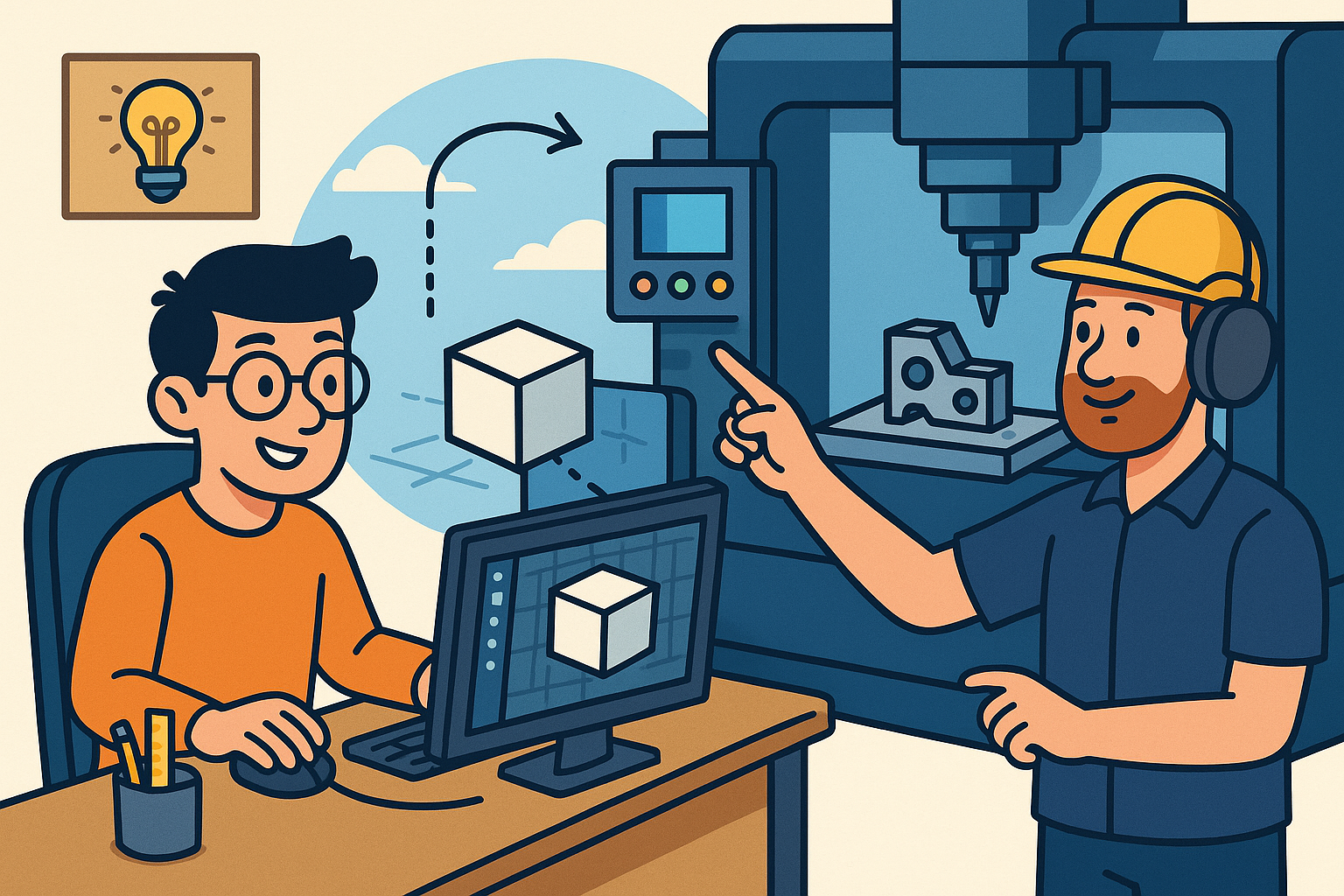Your Cart is Empty
Customer Testimonials
-
"Great customer service. The folks at Novedge were super helpful in navigating a somewhat complicated order including software upgrades and serial numbers in various stages of inactivity. They were friendly and helpful throughout the process.."
Ruben Ruckmark
"Quick & very helpful. We have been using Novedge for years and are very happy with their quick service when we need to make a purchase and excellent support resolving any issues."
Will Woodson
"Scott is the best. He reminds me about subscriptions dates, guides me in the correct direction for updates. He always responds promptly to me. He is literally the reason I continue to work with Novedge and will do so in the future."
Edward Mchugh
"Calvin Lok is “the man”. After my purchase of Sketchup 2021, he called me and provided step-by-step instructions to ease me through difficulties I was having with the setup of my new software."
Mike Borzage
Integrating CNC Machining into Modern Design Workflows: Enhancing Precision and Efficiency
June 05, 2025 9 min read


Introduction to Integrating CNC Machining into Design Workflows
Integrating **CNC machining** technology into modern design workflows represents a pivotal evolution in advanced manufacturing practices. CNC machining, which stands for Computer Numerical Control machining, leverages computer-controlled tools to produce highly accurate components from a range of materials. This capability is integral to modern manufacturing, where production speed and precision are paramount, and its influence has transformed traditional methods into agile, efficient processes. By incorporating CNC machining technology early in the design process, engineers and designers are able to assess feasibility at the conceptual stage, minimizing costly iterations in physical prototyping. Moreover, this integration allows for **design software** applications to evolve with built-in modules that support toolpath generation, simulation, and parametric modeling. In doing so, designers can visualize how a design will transition from a digital model to a physical part, fostering improved communication between departments. This initial step of integrating CNC into design not only streamlines product development cycles but also reduces lead times and material waste, thereby optimizing overall operational efficiency.
Defining CNC Machining and Its Modern Role
At its core, CNC machining employs pre-programmed computer software to dictate the movement of factory tools and machinery, cutting materials in multifaceted ways that human hands alone could not achieve. This capability allows manufacturers to maintain tight tolerances and high repeatability when fabricating complex components. Historically, machining was reliant on manual operations which were time-consuming and more prone to error. Today, by embedding CNC capabilities into design environments, manufacturers can simulate and validate designs before physical production, resulting in fewer errors during manufacture. The ability to digitally simulate a machining process provides designers with insights into potential challenges such as tool collision or surface finish issues. The resulting synergy between design and production not only reinforces precision but also enhances the reliability of final products; it emphasizes how early-stage design adjustments can have a significantly positive impact on the manufacturing outcome.
Streamlining Product Development through Integration
The convergence of **design software** and CNC machining is a testament to the rapid technological advancements in manufacturing processes. Modern design platforms now incorporate specialized features that allow the automation of generating toolpaths, direct translation of digital models into machine-readable instructions like **G-code**, and real-time simulation, effectively bridging the gap between creative design and practical manufacturing. This integration is crucial for industries where the speed of market introduction is tied directly to manufacturing agility and precision. Implementing a workflow that incorporates CNC considerations from the initial design phase also helps in spotting design redundancies and eliminating potential production issues early on. Beneficial aspects include reduced prototyping costs, improved collaboration between design engineers and production teams, and more informed decision-making based on immediate feedback from simulated production processes. Such integration also supports advanced studies into material behavior under machining processes, yields highly optimized components, and propels industries toward lean manufacturing paradigms. Designers also gain the flexibility to iterate more rapidly and align their creative vision with realistic manufacturing constraints.
Technical Integration of CNC Capabilities into Design Software
The technical foundation for incorporating **CNC machining** into design software lies in embedding advanced simulation capabilities, toolpath algorithms, and precise file format translators within the design environment. Modern software packages now come equipped with features that allow the generation of machine-readable instructions, such as **G-code** or STEP files, which ensure that the intricate details of a digital model are accurately translated into actionable commands for CNC machines. Real-time simulation modules and parametric modeling capabilities ensure that designers can instantly evaluate the manufacturability of a part while also accounting for potential limitations of CNC technology. The seamless integration of these features minimizes discrepancies between the original digital design and the final physical product, thereby curtailing the typical setbacks encountered in transitioning from design to manufacturing. This technical merge, however, is not without challenges. Software compatibility, the need for periodic updates, and the steep learning curves associated with these advanced features are factors that must be addressed proactively. The design process becomes a continuous conversation between the virtual and physical realms, where both design accuracy and operational efficiency complement one another to yield superior product outcomes.
Key Software Features Enabling CNC Compatibility
One of the most transformative aspects of modern design software is its ability to integrate CNC-specific features directly into the modeling environment. Among these features, toolpath generation is critical: it computes the exact trajectories that a CNC tool must follow to mill or cut the part from a raw material block. Simulation modules further allow designers to visualize the final output, checking for interruptions and ensuring that the digital model is fully machinable. Additionally, software now supports **real-time simulation** capabilities that can instantly detect potential design flaws or collisions. The automation present in these modules not only enhances the design-to-manufacturing efficiency but also serves as an essential quality control measure. The incorporation of a comprehensive suite of CNC tools in design software allows for iterative testing, ensuring that each alteration in the design is instantly reflected in the formation of tool paths and machining sequences. This process fosters a clarified relationship between the intended design and the produced component, reducing operational inefficiencies in production environments.
Role of File Formats and Data Exchange Standards
Effective communication between design software and CNC machinery is largely enabled by standardized file formats and data exchange protocols. Formats such as **G-code** for machine instructions and STEP files for model exchange are essential links in the chain of production. These standards enable consistent value translation from design to machine, ensuring that the geometry, toolpaths, and machining parameters are accurately shared across platforms. The interoperability of these file formats means that even when proprietary software is used in the design phase, manufacturers can leverage universal standards to communicate with CNC controllers. This standardization simplifies the collaborative process between departments and minimizes errors that can occur when data are manually transferred between systems. In addition, modern design tools frequently incorporate direct export options to these canonical formats, reducing the need for intermediary software conversions. As a result, the risk of data corruption or loss during file transfers is markedly reduced, leading to a more robust and efficient production line that confidently scales with emerging technologies.
Importance of Parametric Modeling and Real-Time Simulation
Parametric modeling and **real-time simulation** have emerged as cornerstone methodologies that empower engineers to iteratively refine their designs with confidence. With a parametric approach, every dimension and geometric relationship within a model is interrelated, meaning that a single modification triggers automatic updates throughout the design. This ability facilitates rapid iterations and swift identification of design issues that may interfere with CNC machining operations. Furthermore, real-time simulation allows designers to review how a CNC machine will interact with the model in a virtual environment, identifying tool collisions and verifying that the programmed toolpaths yield the intended geometries. The integration of these functionalities in design software allows for predictive adjustments and harnesses computational power to address potential manufacturing bottlenecks. Designers no longer have to rely solely on retrospective feedback but can proactively shape the machining process, ensuring high fidelity between the digital design and the manufactured part. This capability enhances overall production robustness and fosters an environment where design optimizations are continuously tested and validated against real-world manufacturing constraints.
Benefits and Challenges of the Integration
Integrating **CNC machining** directly into the design process offers myriad benefits that extend from initial concept to final production, ultimately transforming the manufacturing landscape. One significant benefit is the seamless flow from design to manufacture, which enables designers and engineers to collaboratively build products that are optimized for both aesthetics and functionality. By embedding machining considerations within the design software, product developers are equipped to mitigate errors early on, thereby shortening production cycles and reducing costs. The integration also enhances productivity by allowing rapid prototyping and iterative testing, leading to efficiently refined designs that meet exact specifications. Furthermore, cross-discipline collaboration is improved, as both the design and manufacturing teams are aligned around a single, integrated digital model, which fosters transparency and reliability in product production. This holistic approach not only improves product quality but also sharpens competitive advantage in a market that demands faster turnarounds and greater precision.
Enhanced Efficiency and Accuracy in Production
One of the most immediate benefits of the integration is the realization of increased design-to-manufacturing efficiency. With the preparatory work being performed in an integrated software environment, the transition from a digital design to a physically machined product becomes a largely automated process. This automation minimizes errors that might otherwise occur during manual data transfers and streamlines the overall production process by reducing the time spent on prototyping and iterative adjustments. The enhanced accuracy ensures that the final product faithfully reflects the digital model, maintaining tolerances and surface finishes that are critical in high-stakes manufacturing environments. In addition, the built-in simulation and testing frameworks allow manufacturers to assess the impact of design changes in real-time, thereby optimizing production cycles and reducing the potential for costly rework. The automation and simulation features collaboratively contribute to a robust production ecosystem where designs are not only visually compelling but also practically manufacturable, thereby enhancing market responsiveness and operational excellence.
Challenges in Integrating Legacy and Modern Systems
Despite the evident benefits, the integration of CNC machining into design workflows is not without its challenges. One of the primary hurdles involves overcoming compatibility issues between legacy systems and modern design software. Many established manufacturing environments operate with older machinery and control software that may not seamlessly support the latest digital file formats or simulation protocols. This technological gap can hinder the direct transfer of design data, leading to potential inaccuracies and discrepancies in the final product. Additionally, the rapid pace of innovation in CNC technology means that design software must continuously evolve to support new machining techniques, updates in data exchange standards, and innovative toolpath algorithms. Such rapid evolution often creates a scenario where training and adaptation become critical bottlenecks, as design teams must frequently update their skill sets and workflows to remain proficient. These challenges can be addressed through deliberate planning, adoption of standard file formats, and targeted training programs that facilitate the smooth transition for design professionals to modern integrated regimes. Embracing these challenges as opportunities for continuous improvement leads to a more agile and dynamic production environment.
Strategies to Overcome Integration Challenges
Overcoming the hurdles associated with integrating CNC machining into design workflows requires a strategic approach that considers both technological and human factors. To bridge the gap between legacy systems and modern software, manufacturers must invest in middleware solutions that allow for seamless data translation between different platforms. This method often involves employing standardized protocols, such as the use of STEP files, to ensure consistent data interpretation across various systems and machines. Additionally, fostering a culture of continuous learning and upskilling within the design and engineering teams proves essential. Workshops, focused training sessions, and active collaboration with software vendors can help mitigate the friction encountered during the transition phase, ensuring that the potential of integrated CNC capabilities is fully leveraged. Moreover, iterative pilot projects that test the new integrated workflows in controlled environments can provide valuable insights into unforeseen challenges and guide the refinement of the software integration process. By addressing these issues proactively, companies can maintain the rhythm of production while simultaneously enhancing the accuracy and precision of their manufactured components.
Conclusion
The integration of **CNC machining** capabilities into design workflows is a transformative milestone in modern manufacturing, enabling unparalleled efficiency, accuracy, and collaboration across product development stages. By embedding advanced simulation modules, automated toolpath generation, and real-time validation tools within design software, manufacturers can bridge the longstanding divide between digital design and physical production. This integrated approach significantly reduces lead times, minimizes errors, and cultivates an environment where design modifications are promptly addressed within the manufacturing context. The ongoing evolution of standards, such as **G-code** and STEP file formats, ensures that the connection between design and production remains robust and adaptive. However, as with any technological advancement, the integration poses challenges—particularly in reconciling legacy systems with modern software tools and ensuring that teams remain current with emerging machining technologies.
Recapping the Transformative Impact
In summary, the transformative impact of integrating CNC machining directly into design workflows cannot be understated. The efficient communication and data exchange between design models and CNC controllers not only streamline production but also facilitate enhanced collaboration between design engineers and manufacturing teams. This integration provides a cohesive framework for addressing challenges in modern manufacturing, ensuring that digital designs are rapidly refined into high-quality physical components. The adoption of **integrated solutions** represents a critical step towards a future where software innovation and advanced manufacturing technology operate in tandem, ushering in an era of agile and interconnected production systems. Advancing these integrated workflows continues to be central in maintaining industrial competitiveness, as manufacturers are increasingly called upon to produce intricate components with both speed and reliability. This paradigm shift towards digital integration serves as a compelling model for future innovations in product design and manufacturing.
Encouraging Future Innovation and Adoption
Looking forward, it is clear that continued innovation in **design software** alongside advancements in CNC technology will be imperative to meet the rising demands of an increasingly competitive market. The evolution of software tools, which now incorporate more intuitive interfaces, enhanced real-time simulation, and parametric modeling techniques, lays a strong foundation for future growth. As industries move towards more agile production systems, the need for interconnected and efficient workflows becomes even more pronounced. Companies should view the integration of CNC machining into their design protocols not merely as a technical upgrade, but as a strategic investment that promises to yield significant dividends in product quality, production speed, and overall operational resilience. Embracing these integrated solutions today not only streamlines current manufacturing practices but also paves the way for the next generation of design innovation, ensuring that companies remain at the forefront of technological advancement and market responsiveness.
Also in Design News

Cinema 4D Tip: Unified Color Management for Cinema 4D Pipelines
January 11, 2026 2 min read
Read More
V-Ray Tip: V-Ray Render Mask: Targeted Patches and Cross-Engine Blending
January 11, 2026 2 min read
Read MoreSubscribe
Sign up to get the latest on sales, new releases and more …



